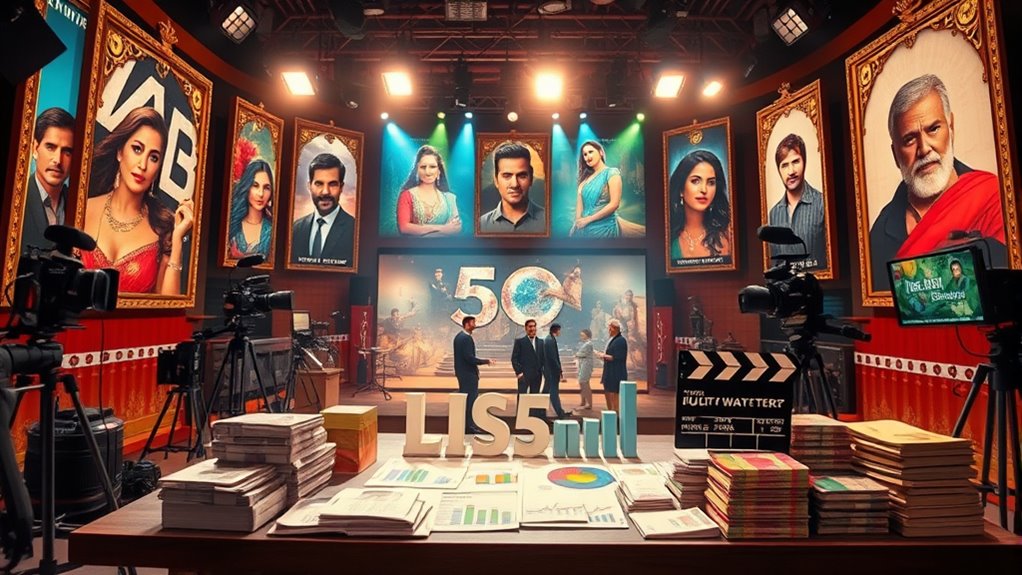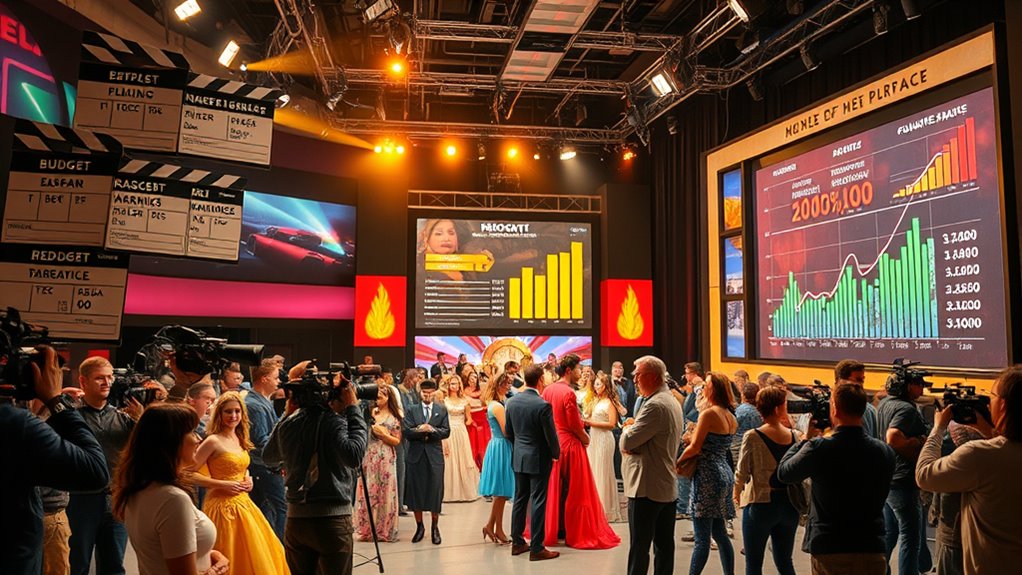The economics of multi-starrer films show that higher budgets are necessary due to multiple star salaries, which means more spending on sets, effects, and marketing. To guarantee profits, you’ll need strong marketing campaigns that leverage each star’s fanbase and release the film during peak times like festivals or holidays. This approach boosts audience interest and box office revenue. If you want to understand how these strategies work together, keep exploring how producers balance costs and profits.
Key Takeaways
- Multi-starrer films require larger budgets for cast, sets, effects, and marketing, impacting overall production costs.
- Star power is leveraged in marketing to generate buzz and attract diverse audiences, boosting box office potential.
- Higher investments in cast and promotion aim to maximize revenue through increased audience turnout and premium ticket pricing.
- Strategic release timing during holidays or festivals enhances commercial success and optimizes box office performance.
- Effective financial planning balances costs and marketing to ensure profitability and maximize return on investment.

Have you ever wondered why multi-starrer films often generate so much buzz and box office buzz? It all boils down to strategic financial planning and marketing tactics. When studios decide to produce a film with multiple big-name actors, the first thing they focus on is budget allocation. Unlike solo-hero projects, multi-starrer films demand a larger slice of the budget to accommodate multiple star salaries, which can be significant. This higher investment isn’t just about paying stars; it also covers the costs of more elaborate sets, special effects, and extensive marketing campaigns. Studios have to carefully balance these expenses to guarantee the film can turn a profit, which often means scaling up the budget for the cast and production while trying to manage costs elsewhere.
Marketing strategies play a vital role in the economics of multi-starrer films. Because these movies feature several high-profile actors, studios leverage the star power to generate excitement and anticipation. They craft campaigns that highlight each star, creating a sense of event cinema that appeals to diverse fanbases. This multi-pronged approach ensures that the film reaches a wide audience, both domestically and internationally. Trailers, posters, social media campaigns, and interviews focus on the ensemble cast, making the film seem like an unmissable spectacle. This targeted marketing not only boosts pre-release hype but also helps sustain audience interest through the film’s theatrical run. Additionally, the presence of multiple stars often allows studios to negotiate better distribution deals, further boosting revenue potential.
The presence of multiple stars also influences ticket pricing strategies. Studios often position multi-starrer films as premium entertainment, which can justify higher ticket prices in certain markets. Additionally, the film’s star-studded appeal makes it more likely to attract larger audiences, increasing box office revenue. But all of this hinges on effective marketing strategies that showcase the film’s ensemble strength and generate widespread buzz. The combination of well-planned budget allocation and aggressive marketing ensures that these films can recover their hefty investments and, ideally, maximize profits.
Furthermore, studios often plan release dates carefully, aiming for holiday seasons or festival periods when audiences are more willing to spend on big-ticket entertainment. This timing, coupled with blockbuster marketing campaigns, amplifies the film’s commercial potential. Ultimately, the economics of multi-starrer films depend on how well the studio manages the delicate balance between investment and promotion. When done right, these movies not only recoup their costs but also set new benchmarks at the box office, thanks to the combined power of star appeal and strategic marketing. Understanding the production costs involved helps studios make informed decisions about casting and marketing investments, ultimately influencing the film’s financial success.
Frequently Asked Questions
How Do Multi-Starrer Films Influence Regional Box Office Dynamics?
Multi-starrer films substantially influence regional box office dynamics by attracting diverse regional audiences and boosting ticket sales. You notice star rivalry sparks excitement, drawing fans from different areas to theaters. The combined star power appeals across regional boundaries, increasing revenue potential. This strategy leverages local preferences and rivalries, maximizing box office returns in specific regions. Overall, multi-starrer films create a competitive edge, fostering regional audience engagement and expanding market reach.
What Is the Impact of Star Power on Film Marketing Budgets?
Oh, the magic of star power—it’s like giving your marketing budget a rocket boost! You’ll pour more into marketing strategies and branding partnerships because everyone wants to ride on the coattails of fame. Stars attract audiences, so you spend big to highlight their presence. This boosts visibility, but beware: it can quickly drain your budget if you don’t balance star wattage with smart marketing.
How Do Multi-Starrer Films Affect Emerging Actors’ Career Prospects?
When you appear in a multi-starrer film, casting conflicts can limit your screen time, making it harder to showcase your talent. You might also face actor overshadowing, where established stars dominate the spotlight, overshadowing emerging actors like you. While such films can boost overall visibility, they often challenge your ability to stand out, potentially impacting your career prospects unless you secure a significant role that highlights your skills.
Are Multi-Starrer Films More Profitable Than Solo Star Projects?
You might wonder if multi-starrer films are more profitable than solo projects. These films often feature ensemble casts, which can boost star synergy and attract diverse audiences. While they tend to have higher production costs, the combined star power can lead to bigger box office hits. Overall, their success depends on effective collaboration and audience appeal, making multi-starrer films potentially more lucrative when well-executed.
How Do International Markets Respond to Multi-Star Bollywood Films?
They say “the whole is greater than the sum of its parts,” and this rings true internationally. When you explore global distribution of multi-starrer Bollywood films, you see they often draw diverse audiences. Cultural adaptation plays a key role, as filmmakers customize content for different markets. This approach boosts appeal, making international response generally positive, especially in regions craving vibrant storytelling and star power.
Conclusion
So, as you can see, multi-starrer films are like a bustling marketplace, where each star adds their own flavor to attract diverse crowds. While they can boost box office numbers and create buzz, they also come with risks that can turn this vibrant scene into a fragile mosaic. Ultimately, understanding the economics behind these films helps you see through the glitter and realize that their success depends on a careful dance of stars, story, and strategy.








